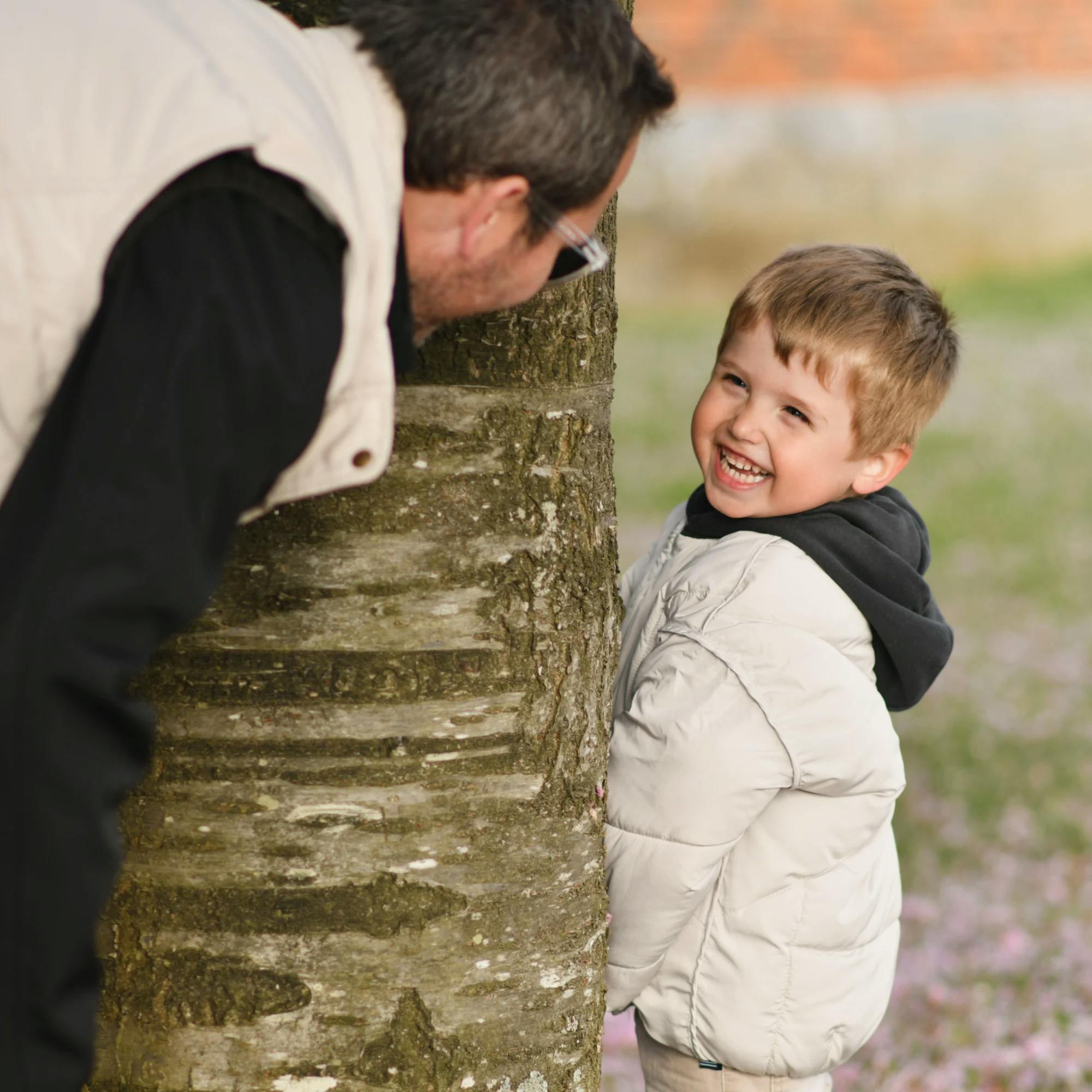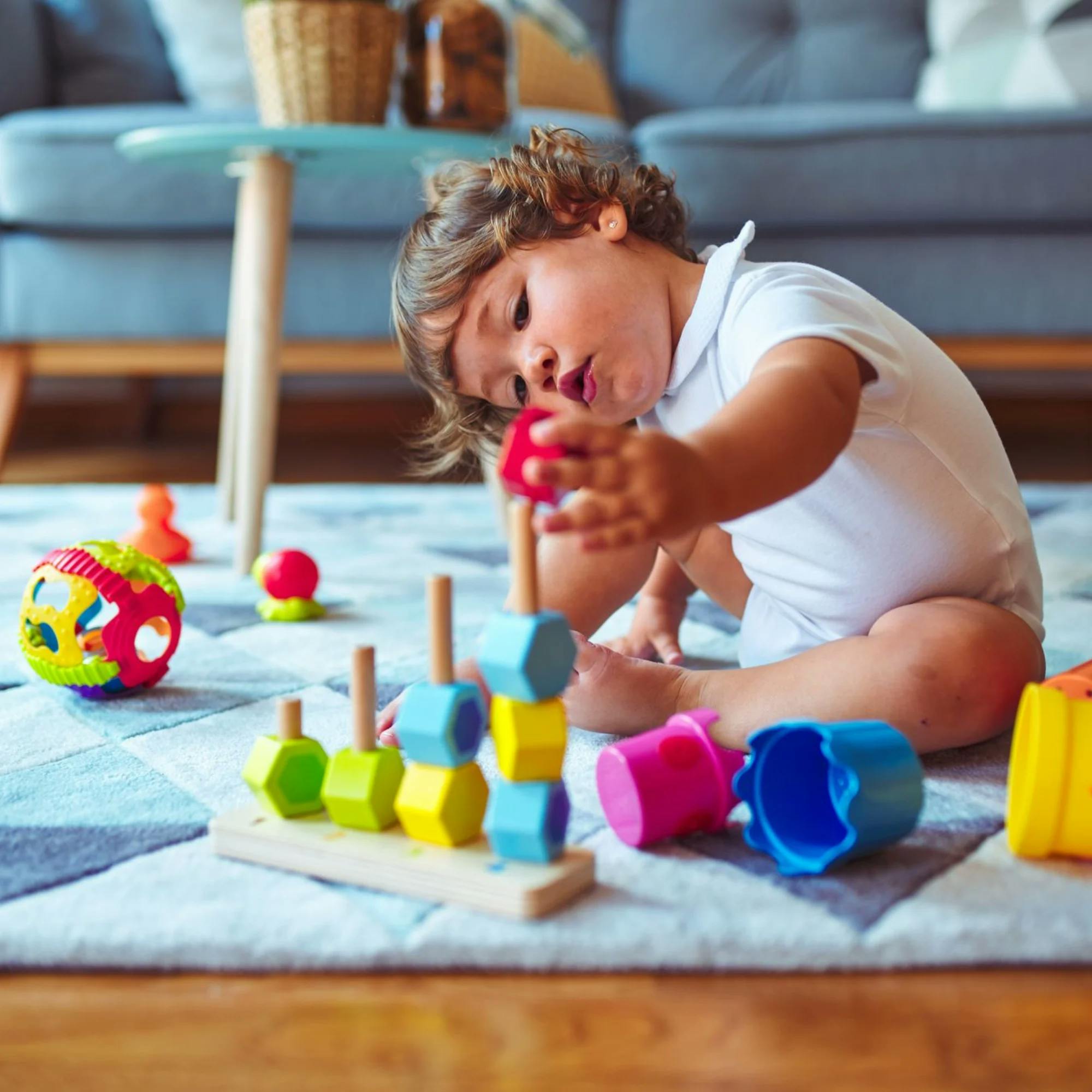It’s not always easy coming up with activities to keep kids entertained. When the usual toys get old and the dreaded “I’m boooored” is heard, why not try a simple new craft? As a bonus, making crafts is an easy way to fit in some speech and language practice at home.
Here are 7 crafts you can do with your child while working on their speech and language skills.
Caterpillar Craft: Help your child practice naming colors
Identifying and naming colors is an easy goal to target in crafts. This Caterpillar Craft is perfect for working on colors.
For this activity, you’ll need:
Pom poms of different colors
Glue dots
Googly eyes*
*Keep children supervised with these small pieces, which can be choking hazards.
Directions:
1. First, gather all the pom poms. Help your child sort them into groups by color. As you do this, talk about the names of the colors. Say, “Let’s find all the blue dots,” or “Let’s find all the red dots.” Hands-on activities like this will help your child learn the colors’ names. 2. Next, place a pom pom on a glue dot and push them together. Then peel the glue dot away, making sure it stays on the pom pom. Add another pom pom to the other side of the glue dot so they stick together. Continue with this to make the pom poms stick together and build a body for the caterpillar. 3. Make caterpillars that are all one color. You can talk about the “green caterpillar” and the “pink caterpillar” to further teach the names of colors. 4. Stick a bigger pom pom on one end for a head, and add googly eyes.
Your child will love their creation! Ask them “Where is the blue caterpillar?” Or “Where is the green caterpillar?” once you are done to see if they can receptively identify each color.


Coffee Filter Butterflies: Help your child practice naming colors
You can target colors with this butterfly craft as well. As your child creates the butterfly, help them practice naming the colors of their markers. You can name the colors, too, and have your child point them out. This way you’re working on both expressive and receptive language skills.
For this craft, you’ll need:
Coffee filters (2 per butterfly)
Washable markers or paint
Spray bottle of water
Clothespin (1 per butterfly)
Pipe cleaners
Wax paper, or something else to cover your workspace and keep it clean
Directions:
1. First, lay 2 coffee filters on top of each other on top of wax paper. 2. Let your child color on one coffee filter. The colors will bleed through to the coffee filter underneath. 3. Next, spray the coffee filters with water to make the colors spread out. 4. Paint or color the clothespin. 5. Once they are dry, fold the coffee filters back and forth like an accordion, and clip the clothespin in the middle to make the body of the butterfly. 6. Fan the coffee filters out to make the wings of the butterfly. 7. Cut a pipe cleaner in half and feed it under the top of the clothespin. Pull each side up to create the butterfly’s antennae.


Toilet Paper Roll Frog: Teach your child to follow directions
When you’re making crafts, there are many directions to follow. Some kids need to work on improving their ability to follow directions. A craft is a great way to practice! Let’s look at how to teach your child to follow directions while making this adorable Toilet Paper Roll Frog.
You’ll need the following materials:
2 toilet paper rolls or 1 paper towel roll
Green paint
Black marker
White, black, and red cardstock paper
Extra strong glue
Directions:
1. First, paint the toilet paper rolls or paper towel roll green. If using a paper towel roll, cut it into smaller pieces. 2. With pencil, trace around the glue stick or any circular item on white cardstock to make two frog eyes. Do the same with a smaller circular item on a black piece of paper. Then cut out all the circles and glue the black circles on top of the white to create the frog’s eyes. 3. Glue the frog’s eyes at the top of one toilet paper roll. 4. Draw a smile on the frog with black marker. 5. Cut a piece of red cardstock to create the frog’s tongue. Glue it on. You can curl it if you like! 6. Cut little feet off the other toilet paper roll or scraps from the paper towel roll. Glue these to the bottom of the paper towel roll. 7. Cut strips off the extra roll to create the frog's legs. You can paint the inside of the legs green, as well. Glue them to the side of the first roll.
Your child may be able to follow some of these directions on their own, but others may be too difficult. For example, cutting out shapes from the toilet paper roll may be a better task for an adult. To practice following directions, look for steps your child can follow with just a bit of help. Examples might be “Hand me the marker,” or “Stick the eyes on the dots of glue.”
Give your child the direction a couple of times so they hear it repeated. You can also show them how to follow the direction and have them imitate you. If your child is working on multistep directions, give them a few tasks they can follow at one time. An example could be “Hand me the paper and the glue, then sit down at the table.”
Collage: Teach your child new words
Making a collage is the perfect craft for helping your child name items. If they’re at the beginning stages of learning to use more words, try this one out.
You will need:
A piece of paper (cardstock works best)
Stickers of various items (animals, shapes, foods, characters, etc.)
Items that can be glued to paper (dry macaroni, dry beans, buttons, beads, etc.)
Extra strong glue
*Keep children supervised with these small pieces, which can be choking hazards.
This craft is a simple one! Allow your child to place stickers or glue items (with your help) onto the page. Before you hand your child each item, have them imitate the name of the item or the picture on the sticker after you. For example, if it’s a dog sticker, you can model, or say, “Dog,” and have your child repeat after you. If you think your child can say the word on their own, ask, “What’s this?” and see if they’ll name it.
Watch to make sure your child doesn’t become frustrated. If they don’t imitate you, give them the item and move on to the next one. At the end, they’ll have a beautiful collage to hang on the fridge!


Cactus Handprints: Teach your child to use longer phrases and sentences
If your child is learning to use more words together in phrases or sentences, this can be practiced with just about any craft. Simply pick one that they’ll enjoy and want to talk about with you.
As you complete the craft together, prompt your child to use more words to say what they need. For example, if they need your help and simply say, “Help,” you can have them say, “Help, please!” Or if they’re telling you what color paint they want and just say, “Blue,” have them say, “I want blue!” as a longer phrase.
When practicing this, work just one level above where your child currently is. In other words, if they’re currently saying two words at a time, focus on three words–not a six-word sentence! Just add on a word or two to what they’re currently saying.
Here’s a fun craft idea you do while working on this goal: Cactus Handprints.
For this craft, you will need:
Cardstock paper: green, brown, purple, pink
Small googly eyes
Pink paint
1 cm pompoms
Black marker
*Keep children supervised with the small pieces, which can be choking hazards.
Directions:
1. Trace your child’s handprint on the green paper and cut it out. 2. Fold over a piece of brown cardstock. Place the cactus pot template on the brown cardstock. Cut out the pot. It should open up like a card. 3. Glue the handprint to the back of the pot. 4. Place the googly eyes on the cactus 5. Draw a smile on the cactus. Put pink paint on the face for the cheeks. 6. Add marks with paint to the cactus wherever you like. 7. Trace the flower template on whatever color cardstock you like and cut out the flower shapes. 8. Glue the flowers onto the cactus. 9. Glue a pom pom in the middle of the flower. 10. If you are giving these as a card to someone, write a sweet message inside the flower pot!
As you make the craft together, practice helping your child use longer phrases and sentences like in the examples above.
Paper Plate Lion Craft: Help your child practice the /l/ sound
There are many ways to help your little one practice different speech sounds during craft time. One fun activity is to pick a craft that starts with the sound they’re working on. Let’s look at an example using the letter /l/, a Paper Plate Lion Craft.
For this, craft you will need :
White paper plates
Brown and yellow paint
Brown construction paper
Large googly eyes
Paintbrushes
Scissors
A list of /l/ sound words
As you make the craft together, practice the /l/ sound, or words that start with that sound, before every step of the craft.
Directions:
1. On the outside ring of the paper plate, paint a brown ring. 2. Paint the inside circle of the plate yellow. 3. Cut out a nose from brown construction paper. Glue it in the middle of the yellow circle on the plate after the paint has dried. 4. Glue the googly eyes on the plate. 5. Paint a mouth and whiskers on the face with the brown paint. 6. Cut the brown ring in little snips all around to create the mane.


Letter /s/ Snake Craft: Help your child practice the /s/ sound
If your child is working on their /s/ sound, try this simple Letter /s/ Snake Craft. (For other crafts targeting other speech sounds, check out Pinterest. You will find tons!)
Between each step of the craft, practice the /s/ sound or a word that starts with that sound.
For this craft you will need:
1 sheet of white paper
Cardstock paper: green, red, and any other colors you want
Googly eyes
Pencil and marker
A list of /s/ sound words
*Keep children supervised with the small pieces, which can be choking hazards.
Directions:
1. Trace a thick “S” on green cardstock and cut it out. 2. Glue the “S”-shaped snake onto the white paper. 3. Cut out small triangles of whatever color cardstock you like and glue them onto the snake. 4. Glue the googly eyes on the snake. 5. Cut out a red tongue and glue it onto the snake's mouth.



 Abby Barnes, M.S., CCC-SLP
Abby Barnes, M.S., CCC-SLP










